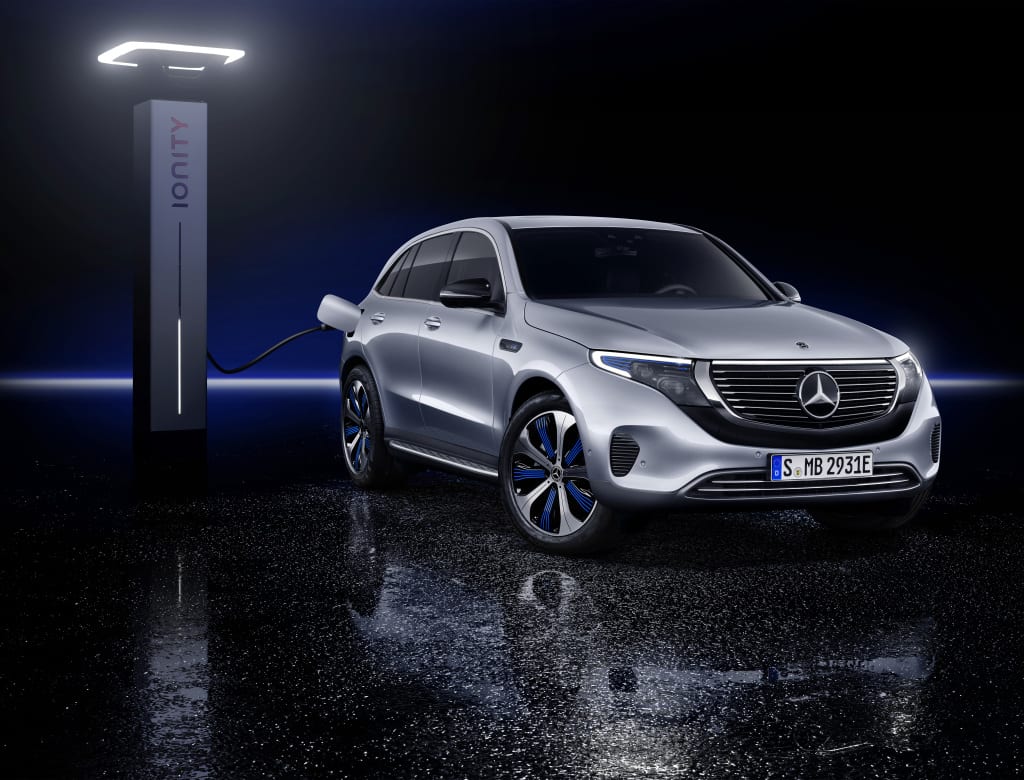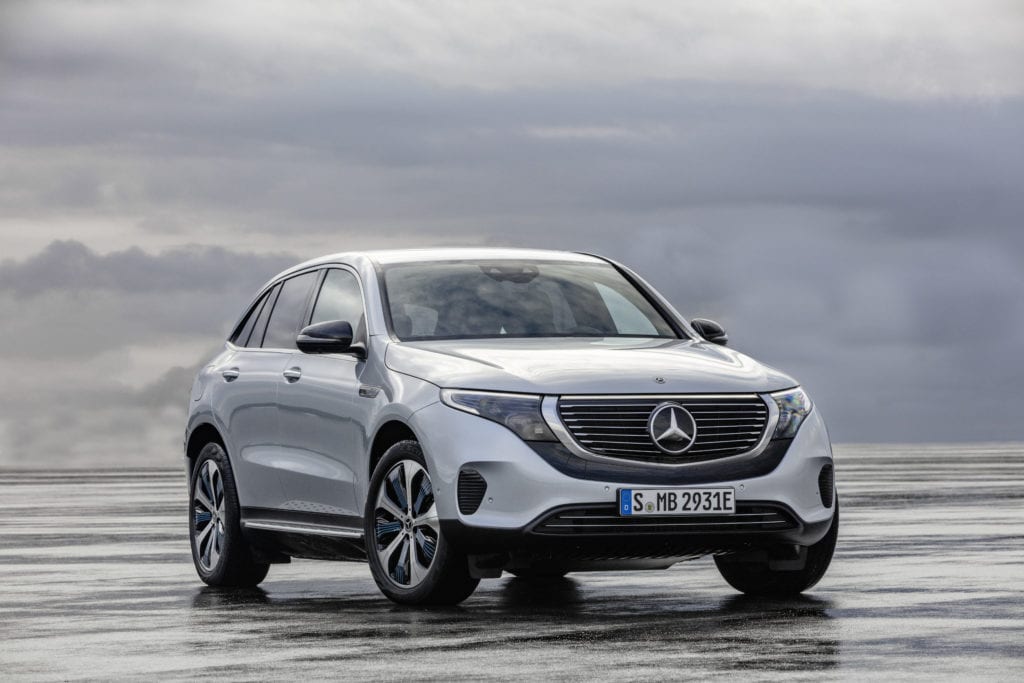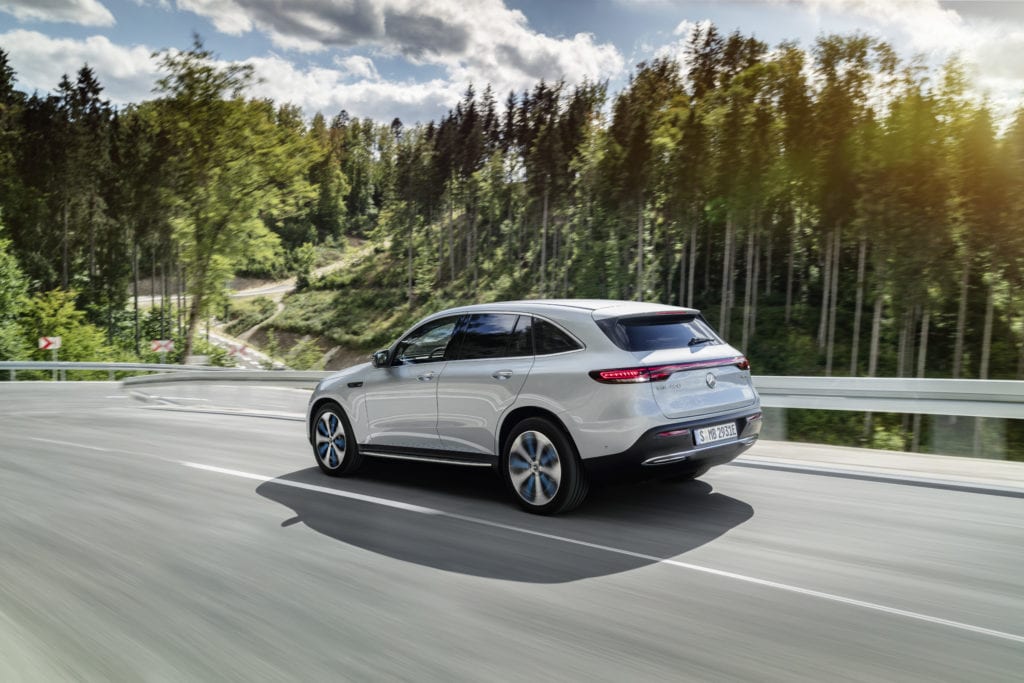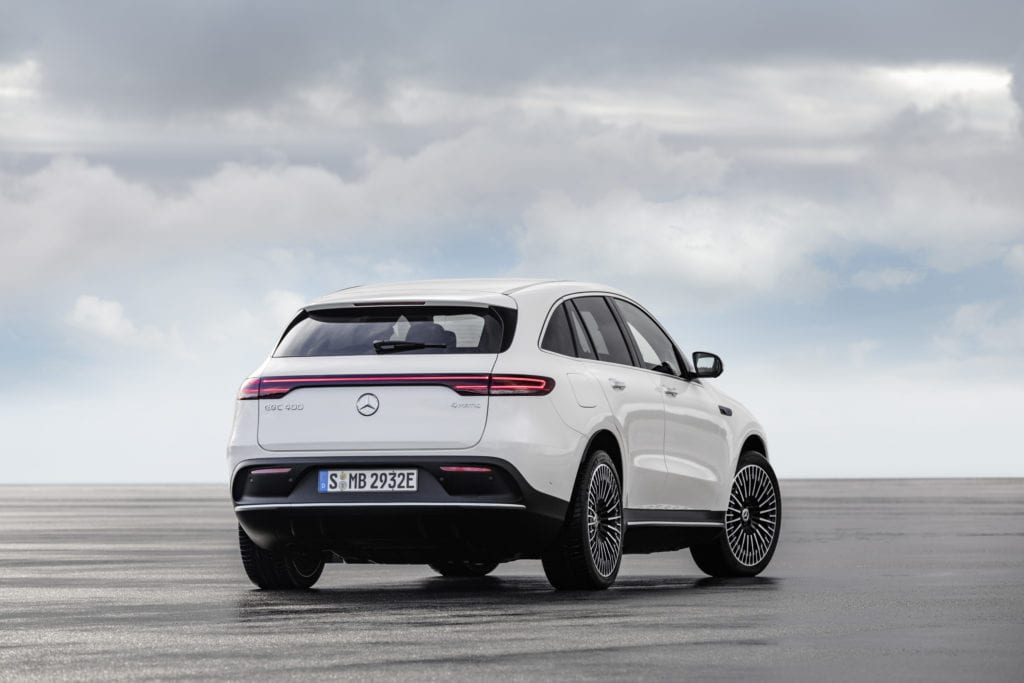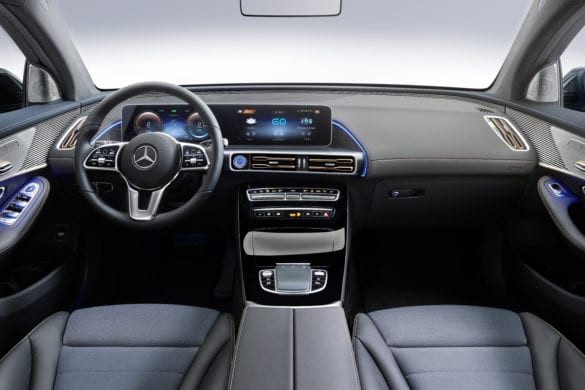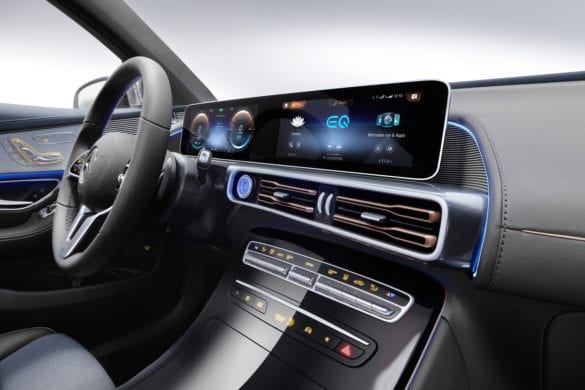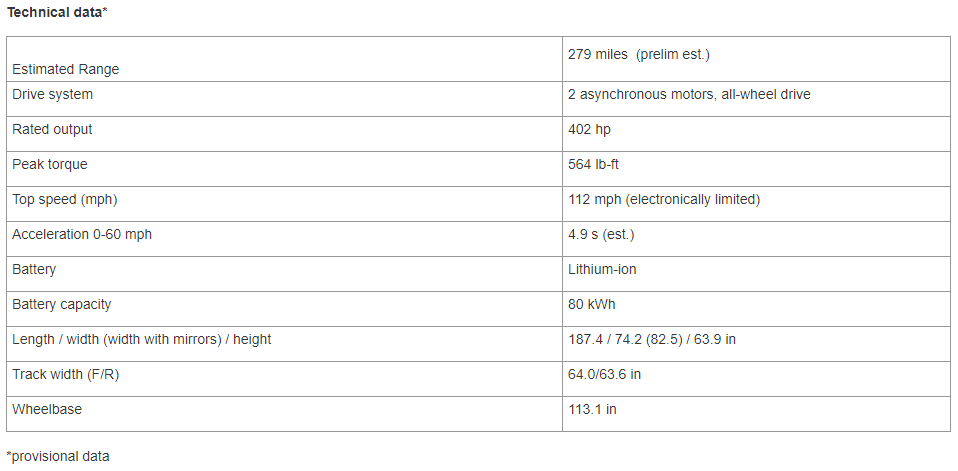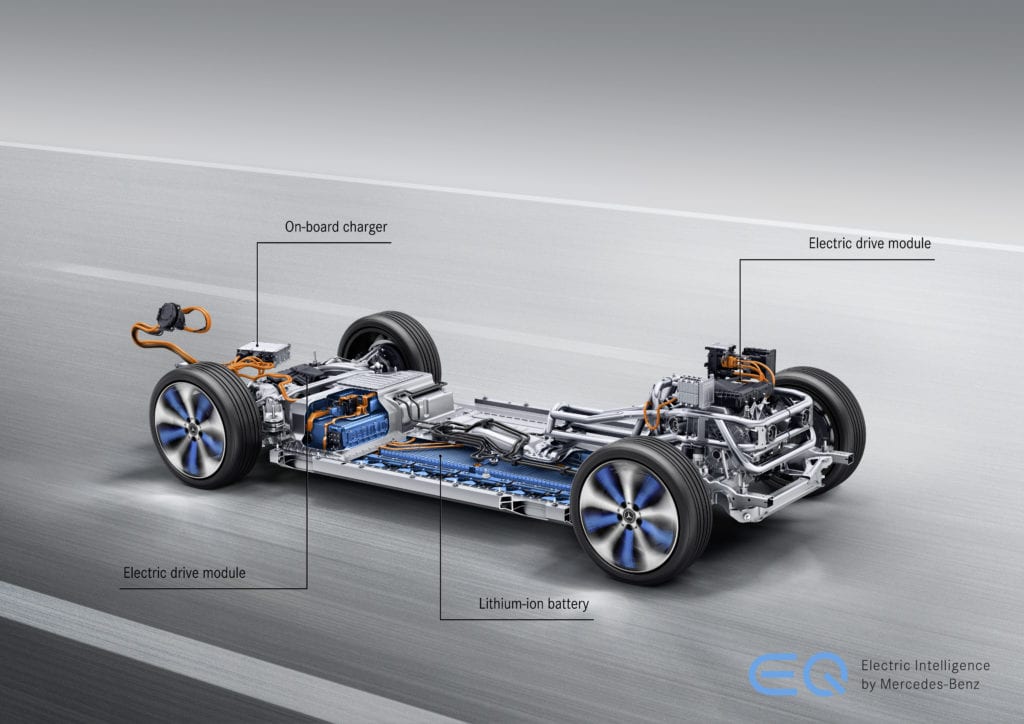After weeks of teasing, Mercedes-Benz has finally pulled back the curtain of its first all-electric SUV, the Mercedes-Benz EQC. The SUV is the first in Mercedes’ brand new EQ line, which incidentally stands for “Electric Intelligence”.
After countless videos and spy shots showing glimpses of the new car we finally got to see it in the flesh. A very important car for Mercedes’ future as Dieter Zetsche, CEO of Mercedes-Benz Cars stated:
“With the EQC – the first fully electric SUV from Mercedes-Benz – we are flipping the switch. Electric drive is a major component in the mobility of the future. We are therefore investing more than ten billion euros in the expansion of our EQ model portfolio, and more than one billion euros in global battery production.”
Exterior
On to the new information regarding the EQC. The design of the car has certainly been toned down from the futuristic styling that most concept EVs have. Gone is the light up grille that we saw in the early concepts, in its place is a more traditional fake grille that falls in line with the styling of the rest of Mercedes’ offerings.
With the design being a little aggressive, but still in line with Mercedes’ design language, Mercedes probably hopes to keep its core customers interested in its new electric offering. Honestly, it looks just like any other regular gas powered Mercedes on the road. But the same can be said for Audi’s upcoming e-tron Quattro and BMW iX3 (at least according to the concept images) so it doesn’t seem to be out of the norm. Still people hoping for some sort of radical departure from current styling might be disappointed.
Interior
As for the interior, it retains the large screen that extends from the gauge cluster to the center console that is found on the S-Class and test vehicle we saw weeks ago. Once again, it doesn’t look to dramatically different from the rest of Mercedes’ models, which is not a bad thing as they make solid looking interiors. The EQC does manage to add some orange accents to parts of the cabin to distinguish itself a bit.
In terms of in-car technology, Mercedes is rolling out an artificial intelligence powered assistant that will help predict the needs of the driver.
The name MBUX – Mercedes-Benz User Experience – for the new multimedia system signifies that the user experience has first priority. A unique feature of this system is its ability to learn thanks to artificial intelligence. With its predictive functions, MBUX anticipates what the user would like next. For instance, anyone who often telephones their mother on Tuesdays during the drive home will receive her telephone number as a suggestion on the display on this day of the week. Anyone who regularly switches over to a radio station with news at a certain time also receives this as a suggestion.
Mercedes is also touting the natural way you can speak to the assistant. For instance you can say “Hey Mercedes, I feel cold” and the car will raise the temperature. This is in contrast to the robotic way of telling the car “Raise the temperature to 72 degrees”. Personally I am weary when automakers try their hands at developing in-car software, it tends to not be worth the hassle or not as fully featured as one would hope. But nonetheless, I hope Mercedes can get it right.
Powertrain
Speaking of something I hope Mercedes can get right, lets talk about the powertrain. The EQC was initially rumored to come with a 70 kWh battery, but will instead be using an 80 kWh battery.
The EQC is equipped with the latest generation of a lithium-ion (Li-Ion) battery serving as the energy source for both electric motors. The battery consists of 384 cells and is located in the vehicle floor, between the two axles. The battery system is modular in design, consisting of two modules with 48 cells each and four with 72 cells each. The powerful high-voltage battery has a nominal voltage of approx. 350 V and a nominal capacity of approx. 218 Ah, for an energy content of 80 kWh (according to NEDC/WLTP).
The worrisome portion is the range that the EQC will be getting. The press release has conflicting numbers, as it sites “An estimated electric range of around 200 miles” and then later on in the technical data states that it has an estimated 279 miles of range.
For the sake of the ECQ I hope that the 279 mile range is the correct version. But even then it might be based on the NEDC test cycle and as such the real world range might be 20-30 miles less. If the range is indeed closer to the 200 mile mark, then one would most likely have to make good use of Mercedes’ new ECO Assist mode which determines in what scenarios would it be beneficial for the car to use its brake regeneration.
Predictive driving for economy – the ECO Assist assistance system comprehensively supports drivers in implementing this effective efficiency strategy: by prompting the driver when it is appropriate to come off the accelerator, e.g. because the vehicle is approaching a speed limit, and by functions such as coasting and specific control of recuperation. For this purpose, navigation data, traffic sign recognition and information from the intelligent safety assistants (radar and stereo camera) are linked and processed.
ECO Assist predictively computes the driving situation when deciding whether to drive with the lowest resistance or whether to recuperate. Examples include dips, brows or speed limits ahead, which the system recognises from the map data.
The driver of course has the option to change to strength of the regenerative braking and enabling coasting just like in a gasoline car. The EQC also comes with various driving modes to choose as you see fit:
- COMFORT: Default setting; accelerator pedal characteristic supports a comfortable driving style, but also automatically becomes more dynamic depending on the driving style.
- ECO: Driving program focused on high efficiency and low consumption.
- MAX RANGE: Intelligent driving program that can help the driver achieve the maximum possible range.
- SPORT: Driving program focused on the best response for the highest driving performance.
- INDIVIDUAL: There is also an individual driving program which allows the various parameters to be adjusted separately.
The EQC sadly only comes with 110 kW charging, so there won’t be any ultra-fast charging here.
Finally, in terms of release date, we don’t know. All we know is that production will start sometime in 2019 in the Bremen factory and then will start being built in China afterwords. No word on pricing either.
Now, I am a fan of the design both inside and out. It looks comparable to the recent of Mercedes’ lineup but still looks nice to me. The big problem is the actual specifications of the car.
Had the EQC been released today, it might have gotten a pass, even with 200 miles of range and the 110 kW charging. But it’s not coming out today, it will come out probably some time in late 2019 or early 2020. At that point these specs will be outdated. The Audi e-tron Quattro which is already put into production has a range of around 250 miles and 150 kW charging (sure its not ultra-charging, but its an incremental improvement). I am hoping that since a lot of these numbers are still “preliminary” that Mercedes will improve them largely enough to be competitive in a year and a half. Because lets face it, the price tag of the EQC will most likely not be less than $70,000-$80,000. And lets face it, for that money, these specs are not worth it.
What do you guys think? Let us know down in the comments below.
Source: Mercedes-Benz
